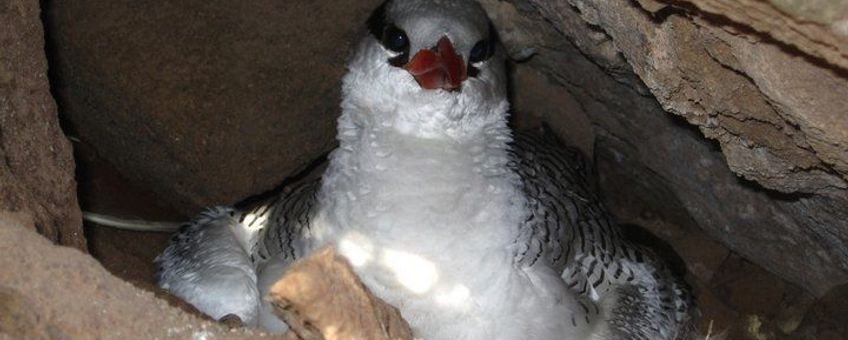
Tropische keerkringvogel indicator natuurkwaliteit op Saba
Bericht uitgegeven door Dutch Caribbean Nature Alliance (DCNA) op [publicatiedatum]
Saba is het belangrijkste broedgebied van de tropische keerkringvogel in het Caraïbisch gebied, en misschien wel van de hele wereld. Het broedseizoen begint altijd met een baltsritueel in de lucht, waarna het vrouwtje één ei legt in een klif of op de grond. Als het ei na 43 dagen uitkomt, zorgen de ouders nog 85 dagen voor hun jong. De tropische keerkringvogel is uitgekozen als indicatorsoort om de gezondheid en veranderingen in de natuur van Saba te meten. Hiervoor tellen de Caraibische natuurorganisaties de vogels en houden ze hun nestgedrag in de gaten.
Lees verder in het Engels…
Red Billed Tropicbird
Saba is believed to host the most significant breeding colonies of Red-Billed Tropicbirds (Phaethon aethereus) in the Caribbean region, and possibly in the entire world. Red-billed Tropicbirds, also known as Boatswain Birds, are striking seabirds, with a vivid, white body, black wing edges and eye stripe, red bill and two long, streaming tail feathers. They are found in the tropical latitudes of the Caribbean, the eastern Pacific and in the Indian Ocean.

Like some of the other pelecaniformes (pelikaanachtigen in het Nederlands), tropicbirds are plunge-divers, feeding on squid and fish, well out at sea. They court each other with an aerial display and callings, then breed a single egg laid directly onto the ground or a cliff ledge for about 43 days. The parents raise their chick for another 85 days, until it fledges. Tropicbirds disperse widely when not nesting and sometimes wander far, including an amazing record from birds that ended up in Great Britain! Saba’s tropicbird colonies are threatened by feral cats and rats, especially during the breeding period.
Tropicbird Monitoring Course Tropicbirds are identified as a key species as part of a new monitoring program to better determine the health and changes of Saba terrestrial and marine environments. Therefore conservationists from the BES islands (Bonaire, Saint Eustatius and Saba) participated in a tropicbird monitoring course on Saba that was organized and funded by the Dutch Caribbean Nature Alliance (DCNA) and facilitated by the Saba Conservation Foundation (SCF). In this course participants learned to record daily nest attendance patterns and bird counts. They were also taught how to handle adults, chicks and eggs, to better understand their breeding biology. At two sites near Fort Bay at Tent and Great Level the study groups counted 63 and 39 birds respectively, flying above the colonies at the same time during the peak hour between three and four p.m.
Tropicbirds are identified as a key species as part of a new monitoring program to better determine the health and changes of Saba terrestrial and marine environments. Therefore conservationists from the BES islands (Bonaire, Saint Eustatius and Saba) participated in a tropicbird monitoring course on Saba that was organized and funded by the Dutch Caribbean Nature Alliance (DCNA) and facilitated by the Saba Conservation Foundation (SCF). In this course participants learned to record daily nest attendance patterns and bird counts. They were also taught how to handle adults, chicks and eggs, to better understand their breeding biology. At two sites near Fort Bay at Tent and Great Level the study groups counted 63 and 39 birds respectively, flying above the colonies at the same time during the peak hour between three and four p.m.
Breeding Tropicbird
Examination of the nests, eggs and chicks revealed that the course, which was held from February 23rd to 26th was still early in the season, which peaks in mid March. Since relatively little is known about the biology and monitoring of Red Billed Tropicbirds, the group will compile a scientific paper under the leadership of course director Dr. Del Nevo, describing the findings of the workshop for future reference to other researchers.
Text and photo's: Dutch Caribbean Nature Alliance
Nederlandse introductie: Sara Mulder, Natuurbericht.nl
